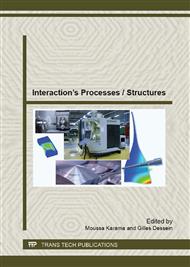[1]
I. Gibson, D.W. Rosen, B. Stucker, Additive Manufacturing Technologies: Rapid Prototyping to Direct Digital Manufacturing, Springer, 2009.
DOI: 10.1007/978-1-4419-1120-9_14
Google Scholar
[2]
R. Campbell, D. Bourell, I. Gibson, Additive manufacturing: rapid prototyping comes of age, Rapid Prototyping Journal, 18-4 (2000) 255-258.
DOI: 10.1108/13552541211231563
Google Scholar
[3]
M. Niino, A. Suzuki, T. Hirai, R. Watanabe,T. Hirano, N. Kuroishi, U.S. Patent 4,571,099. (1998)
Google Scholar
[4]
M.S. Domack, J.M. Baughman, Development of nickel-titanium graded composition components, Rapid Prototyping Journal, 11-1 (2005) 41-51.
DOI: 10.1108/13552540510573383
Google Scholar
[5]
W. Pompe, H. Worch, M. Epple, W. Friess, M. Gelinsky, P. Greil, U. Hempel, D. Scharnweber, K. Schulte, Functionally graded materials for biomedical applications, Materials Science and Engineering: A, 362-1 (2003) 40-60.
DOI: 10.1016/s0921-5093(03)00580-x
Google Scholar
[6]
B. Kieback, A Neubrand, H. Riedel, Processing techniques for functionally graded materials, Materials Science and Engineering: A, 362-1 (2003) 81-106.
DOI: 10.1016/s0921-5093(03)00578-1
Google Scholar
[7]
J. Fessler, A. Nickel, F. Prinz, Functional gradient metallic prototypes through shape deposition manufacturing, Proceedings of the Solid Freeform Fabrication Symposium, Austin, U.S.A., 1997.
Google Scholar
[8]
Y. Pei, V. Ocelik, J. De Hosson, SiCp/Ti6Al4V functionally graded materials produced by laser melt injection, Acta Materialia, 50-8 (2002) 2035-2051.
DOI: 10.1016/s1359-6454(02)00049-6
Google Scholar
[9]
J. Majumbar, I. Manna, A. Kumar, P. Bhargava, A. Nath, Direct laser cladding of Co on Ti-6Al-4V with a compositionally graded interface, Journal of Materials Processing Technology, 209-5 (2009) 2237-2243.
DOI: 10.1016/j.jmatprotec.2008.05.017
Google Scholar
[10]
V. Balla, P. De Vas Con Cellos, W. Xue, S. Bose, A. Bandyopadhyay, Fabrication of compositionally and structurally graded Ti-TiO2 structures using laser engineered net shaping (LENS), Acta Biomaterialia, 5-5 (2009) 1831-1837.
DOI: 10.1016/j.actbio.2009.01.011
Google Scholar
[11]
Q.X. Xia, M.Y. Wong, Simultaneous optimization of the material properties and the topology of functionally graded structures, Computer-Aided Design, 40-6 (2008) 660-675.
DOI: 10.1016/j.cad.2008.01.014
Google Scholar
[12]
X.Y, Kou, S.T. Tan, Heterogeneous object modeling: A review, Computer-Aided Design, 39-4 (2007) 284-301.
DOI: 10.1016/j.cad.2006.12.007
Google Scholar
[13]
J. Kao, F. Prinz, Optimal motion planning for deposition in layered manufacturing, Proceedings of the Design Engineering Technical Conferences, Atlanta, U.S.A., 1998.
Google Scholar
[14]
K.H. Shin, D. Dutta, Process-planning for layered manufacturing of heterogeneous objects using direct metal deposition, Journal of Computing and Information Science in Engineering, 2-4 (2002) 330-344.
DOI: 10.1115/1.1559152
Google Scholar
[15]
A. Xu, L.L. Shaw, Equal distance offset approach to representing and process planning for solid freeform fabrication of functionally graded materials, Computer-Aided Design, 37-12 (2005) 1308-1318.
DOI: 10.1016/j.cad.2005.01.005
Google Scholar
[16]
P. Mognol, P. Muller, J.Y. Hascoet, A novel approach to produce functionally graded materials for additive manufacturing, Proceedings of the Conference on Advanced Research in Virtual and Rapid Prototyping, Leiria, Portugal, 2011.
DOI: 10.1201/b11341-76
Google Scholar
[17]
J.Y. Hascoet, P. Muller, P. Mognol, Manufacturing of complex parts with continuous functionally graded materials (FGM), Proceedings of the Solid Freeform Fabrication Symposium, Austin, U.S.A., 2011.
DOI: 10.1108/rpj-01-2013-0011
Google Scholar
[18]
P. Muller, P. Mognol, J.Y. Hascoet, Functionally graded material (FGM) parts: from design to the manufacturing simulation, Proceedings of the ASME Conference on Engineering Systems Design and Analysis, Nantes, France, 2012.
DOI: 10.1115/esda2012-82586
Google Scholar


